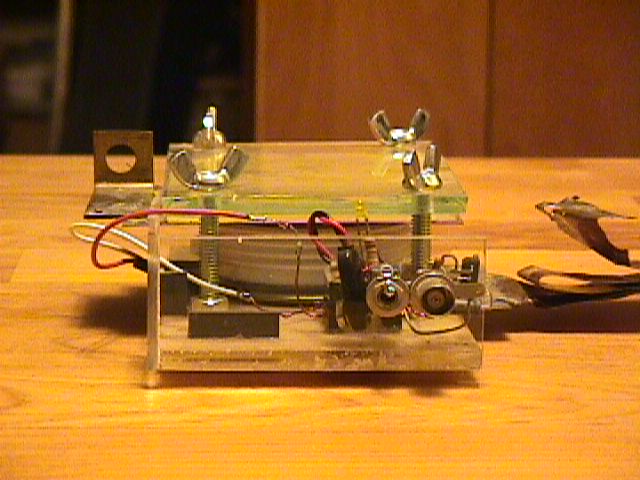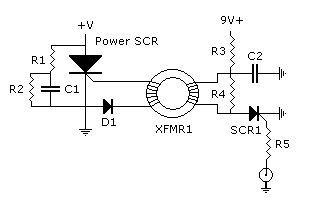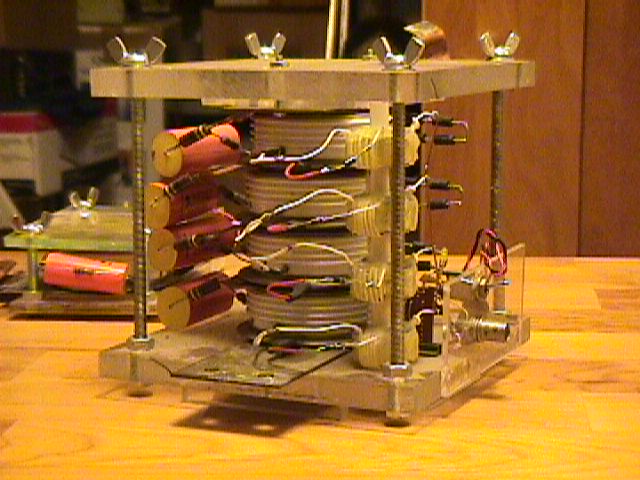|
Research
home page
Power
Pulse SCR
The
SCR is an essential tool for doing power pulse research.
Able to hold off high voltages and handle currents into
the 1000s of amperes, the SCR is the cheapest silicon based
switch money can buy. For pulse work, the driver circuit
can be as simple as a signal pulser and a resistor. But
with a little work an isolated driver can be built to allow
for units to be stacked in series, as well as providing
that extra measure of safety when a megawatt is at one end
of the device and your finger pressing the fire switch is
at the other. Here's a small sample of my SCR switches.
This
unit is a surplus Westinghouse power puk. The housing is
plexiglas with no heat sinking. Unlike continuous duty switching,
power pulse switches tend to fail long before the heat has
had a chance to even get to the sink, much less be dissipated.
For single shot work this simple housing suffices.

The
nine volt battery that powers the trigger circuit has been
removed so you can see the puk. Copper foil leads can be
seen on the right and left, these are the cold and hot sides
of the switch respectively. A 50ohm BNC bulkhead takes the
trigger signal and converts it to a form amenable to the
puk trigger gate. More about the driver in a moment...

Shown
here is the snubber circuit that protects the SCR from voltage
transients and keeps the voltage drop uniform when multiple
units are ganged together. The snubber for this puk is a
.2uF 1000V poly cap in series with 47 ohms. This discharges
into the SCR, turning it on cleanly over a wide range of
pulse forming networks. A parallel resistor of 1 Mohm ensures
a standard DC voltage drop on the switch when open.
Here's
the circuit diagram.

- R1
= 47 ohm
- R2
= 1 M ohm
- C1
= .2uF 1KV poly cap
- D1
= fast 50V signal diode
- R3
= 10K ohm
- R4
= 22 ohm
- C2
= 10 microfarad 50V electrolytic cap
- SCR1
= fast signal SCR
- R5
= 1K ohm
- XFRM1
= 90uH per leg, coupling coefficient of .9
The
circuit is designed to isolate the power pulse side from
the trigger side via the transformer. The diode D1 on
the secondary side prevents voltage reversal across the
power SCR gate, while R4 provides a sink for the back
EMF from the secondary. R3 charges C2 to 9V, and SCR1
is fired by a signal pulse applied to R5. The discharge
of C2 across the primary leg of the transformer induces
a sufficient voltage across the power SCR gate to cause
it to fire. The pulse is 20 microseconds, longer than
the risetime of the SCR but shorter than any reasonable
power pulse width.
With
some slight modification, this kind of circuit can be
used to gang up power SCR's for more voltage. The circuit
shown below is capable of safely switching about 3.5KV.
A single pulse is applied across the primaries of all
the transformers, triggering the gates of the puks synchonously.
Note the snubber ladder, this is crucial to operating
stacked switches. Without it the voltage drop across each
SCR can vary wildly causing failure of that SCR and with
it the entire stack!

|
